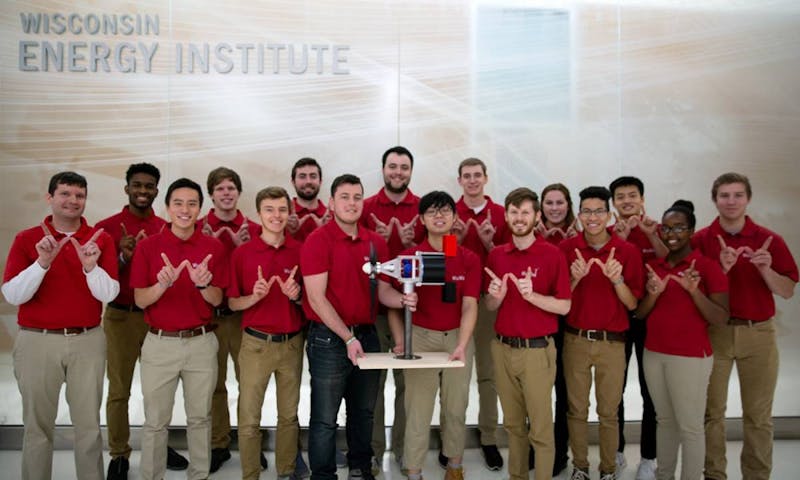
Student organizations and faculty researchers work together to engineer solutions to make campus more environmentally friendly.
Image By: Courtesy of UW Solar Ambassadors
Student organizations and faculty researchers work together to engineer solutions to make campus more environmentally friendly.
Image By: Courtesy of UW Solar AmbassadorsStudent organizations at UW-Madison have pushed building-by-building to make the city and campus source renewable energy.
Three of these organizations, Helios, UW-Madison Solar Ambassadors and WiscWind, are currently working on projects they hope could lead to a sustainable, renewable future.
Last year, the UW-Madison Solar Ambassadors raised $24,000 to help support a renewable energy initiative that cut energy costs for low-income households in Madison and the surrounding counties by extending solar energy to local homes and businesses. The project’s main goal is to reduce carbon footprints, or total emissions, caused by a person or organization.
This year’s project will help bring solar power to Primates Incorporated, a group in Westfield, Wisc. dedicated to the humane treatment of former research lab monkeys. The money saved on electric bills will be used to take better care of the monkeys, according to Will Nicolson, a UW-Madison Solar Ambassadors member and leader of the Primates Incorporated project. Part of the savings will also enter a solar seed fund by RE-volv that will invest in other renewable energy projects at 13 universities from California to Ohio and South Carolina.
“It was cool to see clean energy in action, to see how it’s upheld and how many people benefit from it,” Nicolson said.
The WiscWind team’s main work focuses on objectives set by the U.S. Department of Energy in the Collegiate Wind Competition for undergraduates to train and compete in the core skills of constructing wind energy projects.
These skills include building a wind turbine prototype and testing it in a wind tunnel. Scott Williams, the faculty advisor of WiscWind said there is also a siting challenge where students design hypothetical wind farms. WiscWind won last year’s siting challenge at the American Wind Energy Association in Chicago and hopes to take the lead again in this year’s competition.
Helios also focuses on increasing usage of renewable energy. The group’s projects include the 35 kilowatt photovoltaic installation on Gordon Dining and Event Center and solar bus stops on public transit routes throughout Madison.
While social and institutional change in the Madison community has taken time to realize, Helios co-founder Sahil Verma’s optimism stems from the realization that “it's a slow process,” which — “took years of convincing and converting to do so.”
Campus environmental groups reach out to the community
These campus environmental groups prioritize community as well as education.
The Energy Hub coalition — a student organization dedication to energy issues — will bring together these student groups next fall and invite speakers to a conference on a sustainable future. Energy Hub’s conference last February, which focused on fossil fuels, hosted representatives from the American Petroleum Institute, Morgan Geoscience Consulting and the Great Lakes Bioenergy Research Center.
Education and outreach events like the conference are as important as direct action in building this future, according to Williams..
“We do have a few community-focused activities, including having activity stations at Engineering Expo and Science Expeditions, as well as volunteering for the Wisconsin KidWind Challenge for middle school students,” he said.
Environmental research on campus
Researchers across campus are putting their energy into the environment. At the Nelson Institute for Environmental Studies, Professor Tracey Holloway studies air pollution.
“To me, energy is a priority area of work because any time we’re trying to change what’s in our atmosphere, really we’re changing the energy system,” she said.
One of her advisees, Peidong Wang, compares NASA satellite images against EPA ground monitors to model formaldehyde concentrations in the U.S. Formaldehyde is a carcinogen released to air and ground water through natural gas fracking and can contribute to respiratory illness through ozone formation. Another project evaluates satellite data against computer models of the atmosphere.
This research can support policymakers in their decisions on energy and pollution.
“I think right now there’s still a little bit of a disconnect between data provided by NASA and science agencies and the kind of information that a city health department needs,” Holloway suggested. “Most states and governments have one office that does energy and one office that does air quality. But the planning for how to design systems that consider both is not yet common, and I would like to see those branches brought closer together.”
Holloway pointed to research and development in electric vehicles as a key area for reducing reliance on fossil fuels and for expanding the use of solar, wind, and nuclear power.
“There’s a lot more opportunity to be moving to a clean energy future in a way that may not have been possible a few years ago,” Holloway said.